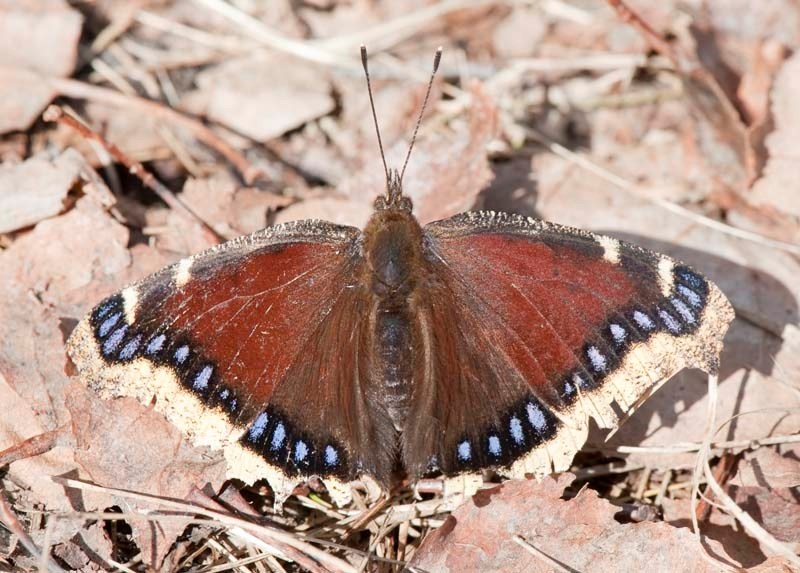You'd expect a creature called the mourning cloak butterfly to be all doom and gloom, but it's not. Indeed, one of my most vivid encounters with them was a celebration of life.
It was early spring, 2010, and I was zipping along the Sturgeon on my bike by the Riel Business Park. Winter had just ended, so the forest was pretty much dead.
Suddenly, a swarm of mourning cloaks materialized in front of me, oblivious to the face full of me approaching at terminal velocity.
I slammed on the brakes, and watched, amazed. There must have been at least six of the palm-sized creatures cavorting about in the air before me.
It was so quiet that you could hear the crisp sound of their wings as they flapped past your ears. Sometimes they would make a slow promenade above the path, gliding along with lazy strokes of their wings. Other times, they'd become a whirl of chocolate and white, waltzing about each other as they twirled towards the heavens.
The mourning cloak is one of our longest-lived butterflies, says local lepidopterist Christianne McDonald, and often the first to emerge each spring.
“It's sort of a sign of hope that summer is coming.”
If you missed them this spring, don't worry – a fresh batch of mourning cloaks should be taking wing in early July, McDonald says.
The mourning cloak is one of the biggest butterflies we get around here, says John “the Nature Nut” Acorn, an entomologist at the University of Alberta, and has a seven centimetre wingspan.
“It's a beautiful maroon brown with a light edge to the outer edge of its wing,” he says – an edge that often features blue spots and turns from yellow to white as it ages. The underside of the wing resembles burnt tree bark.
Researchers think the underside of the wing helps the butterflies blend in when standing still, Acorn says, while the white edge may serve as a decoy – it looks like a tasty caterpillar, and directs hungry beaks away from the fat, furry body.
The mourning cloak is thought to get its name from an old style of cloak people used to wear while in mourning, Acorn says. Europeans also call it the white petticoat and the Camberwell beauty (Camberwell being a place in England where it was found).
Mourning cloaks are one of the few butterflies that overwinter here as adults rather than eggs, McDonald says.
“These guys in particular can live upwards of 10 months, which is a huge lifespan for a butterfly.”
Mourning cloaks will hunker down under bark or in sheds each fall, wait out the cold and re-emerge in the spring.
Mourning cloaks can emerge as early as February if conditions are right, Acorn says. They eat tree sap and rotting fruit early on and switch to nectar as it warms. Males will frequent mud puddles for minerals.
Male mourning cloaks will patrol a specific area (usually a clearing) looking for mates, Acorn says. Disturb one, and it will usually fly away for a short distance and return to the same spot a few moments later – great if you want a picture.
Female mourning cloaks will lay little green eggs on branches that hatch into huge, six-centimetre long black caterpillars covered with nasty (but harmless) black spines and white or red spots.
They're communal feeders, McDonald says, and move en-masse from tree to tree as they run out of leaves. Mature caterpillars will walk off again once it's time to pupate, and will often camp out on the side of your porch.
Look closely at a mourning cloak's body, Acorn says, and you'll notice that it appears to have just four legs instead of the usual six for an insect. Mourning cloaks are part of the brush-foot family of butterflies, he explains, and have tiny, easy-to-miss brush-like front legs that they don't actually walk on. (No one's quite sure what the bugs do with these legs.)
The mourning cloak is the butterfly everyone should know, Acorn says, as it's big, common, and alive year-round.
“You could find a mourning cloak every day of the year in St. Albert.”
They're true Canadians, McDonald adds.
“Butterflies are seen as very delicate and easily damaged, yet somehow these guys survive the harshest of winters.”
Mourning cloak butterfly
Name:<br />Nymphalis antiopa.<br /><br />Appearance:<br />Large butterfly with maroon brown wings edged in white or yellow with blue spots. Bark-like under wing. Caterpillars are black, spikey and huge. <br /><br />Commonly seen:<br />Flitting about clearings at the edge of forests or sunning itself.<br /><br />Often confused with:<br />The white admiral, which is black and has a white band on the inside of the wing, not the outside edge. <br /><br />Fun fact:<br />The caterpillars travel in groups and shake in unison to scare predators.
Wild St. Albert
Like wildlife? So do we! Every second Wednesday the Gazette profiles a reasonably common wild creature in the St. Albert region. Birds, beasts, bugs, fish … so long as it's alive and kicking, we'll feature it. <br /><br />Got a creature you'd like to see profiled? Send your suggestions to [email protected].




